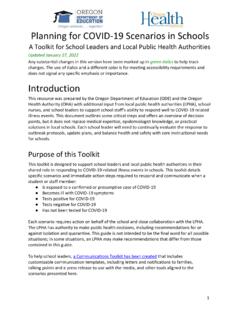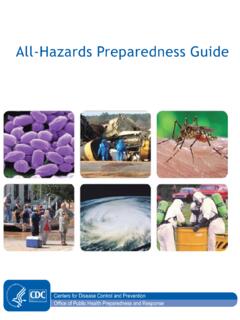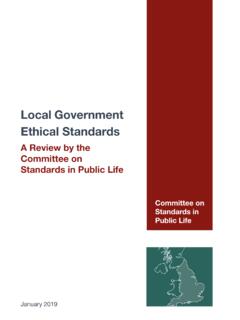Transcription of Working Together to Promote Active Travel A briefing for ...
1 Working Together to Promote Active Travel A briefing for local authorities Working Together to Promote Active Travel : A briefing for local authorities About Public Health England Public Health England exists to protect and improve the nation's health and wellbeing, and reduce health inequalities. It does this through world-class science, knowledge and intelligence, advocacy, partnerships and the delivery of specialist public health services. PHE is an operationally autonomous executive agency of the Department of Health. Public Health England Wellington House 133-155 Waterloo Road London SE1 8UG.
2 Tel: 020 7654 8000. Twitter: @PHE_uk Facebook: Prepared by: Carl Petrokofsky and Adrian Davis For queries relating to this document, please contact: Crown copyright 2016. You may re-use this information (excluding logos) free of charge in any format or medium, under the terms of the Open Government Licence To view this licence, visit OGL or email Where we have identified any third party copyright information you will need to obtain permission from the copyright holders concerned. Published May 2016. PHE publications gateway number: 2016070. 2. Working Together to Promote Active Travel : A briefing for local authorities Contents About Public Health England 2.
3 Summary 4. 1. Introduction 5. A note on methodology 5. 2. Why is Active Travel so important? 6. Physical activity and health 6. The impact of road transport 7. Active Travel : Good for the economy and the environment too 10. 3. Shaping the built environment to increase Active Travel 14. Increasing walking and physical activity 14. Increasing cycling 15. Children and neighbourhoods 15. Older adults and people with disabilities 16. The importance of green spaces 17. Rural communities 18. Travel plans 18. Signs of change 18. 4. Next steps: An agenda for action 20. Achieving change 23.
4 Appendix A: The Infrastructure Act (2015) and the Cycling and Walking Investment Strategy 25. Appendix B: Case studies 26. References 29. 3. Working Together to Promote Active Travel : A briefing for local authorities Summary Walking and cycling are good for our physical and mental health. Switching more journeys to Active Travel will improve health, quality of life and the environment, and local productivity, while at the same time reducing costs to the public purse. These are substantial win-wins' that benefit individual people and the community as a whole. This briefing has been written for transport planners, others concerned with the built environment, and public health practitioners.
5 It looks at the impact of current transport systems and sets out the many benefits of increasing physical activity through Active Travel . It suggests that while motorised road transport has a role in supporting the economy, a rebalancing of our Travel system is needed. Some key messages when developing a healthy local transport strategy include: physical inactivity directly contributes to 1 in 6 deaths in the UK and costs billion a year to business and wider society the growth in road transport has been a major factor in reducing levels of physical activity and increasing obesity building walking or cycling into daily routines are the most effective ways to increase physical activity short car trips (under 5 miles) are a prime area for switching to Active Travel and to public transport health-promoting transport systems are pro-business and support economic prosperity.
6 They enable optimal Travel to work with less congestion, collisions, pollution, and they support a healthier workforce This guide suggests a range of practical action for local authorities , from overall policy to practical implementation. It highlights the importance of community involvement and sets out key steps for transport and public health practitioners. 4. Working Together to Promote Active Travel : A briefing for local authorities 1. Introduction Transport is a key driver of economic growth. It links people to their workplaces and connects businesses. It also affects health, the environment and societal wellbeing.
7 '1. In October 2014, PHE published the national physical activity framework, Everybody Active , Every Day2, to help support a step change in the public's health. Based on international evidence of what works' to increase population physical activity, the framework's main focus is on walking and cycling to help increase physical activity. It highlights the economic and other benefits that would result from having a more Active and healthy population. Half of all women and a third of men in England are damaging their health due to a lack of physical activity3. Everybody Active , Every Day recognises the many ways the built and natural environment impacts on the choices people are able to make to become more physically Active .
8 It emphasises that by developing Active environments', through thoughtful urban design, understanding land use patterns, and creating transportation systems that Promote walking and cycling', we can help to create Active , healthier, and more liveable communities. We need to create environments which Promote physical activity as a normal part of everyday life. For example, walking should be a routine form of Travel , but distances walked have fallen by some 30% between the 1970s and 20134. One fifth of respondents to a national survey said that they rarely or never walk for 20 minutes or more5.
9 This briefing is designed for transport planners and other professionals concerned with the built environment, as well as for public health professionals. It focuses on how we can build Active Travel into everyday life and realise a range of benefits for health, the environment and the economy. This would be a win-win' for local authorities , the NHS, for individuals and their communities. A note on methodology This briefing draws on an existing stock of peer reviewed evidence including that used by the National Institute for Health and Care Excellence (NICE) (eg in Guidance PH86, PH177 and & PH418).
10 It was augmented by online searches for English language papers since 2000 addressing aspects of transport planning and health impacts using a range of search terms. Recent review papers and their references were scanned as a means of capturing evidence that might otherwise have been missed. The specialist knowledge of the main researcher and wider team was also drawn on to ensure that key evidence was taken into account. 5. Working Together to Promote Active Travel : A briefing for local authorities 2. Why is Active Travel so important? Physical activity and health Physical inactivity in England Daily physical activity is hugely important for maintaining health,9 and inactivity directly contributes to one in six deaths in the UK10.

















